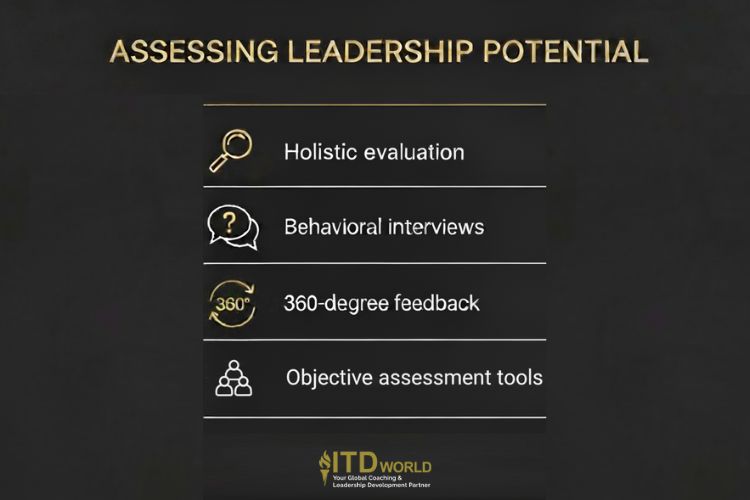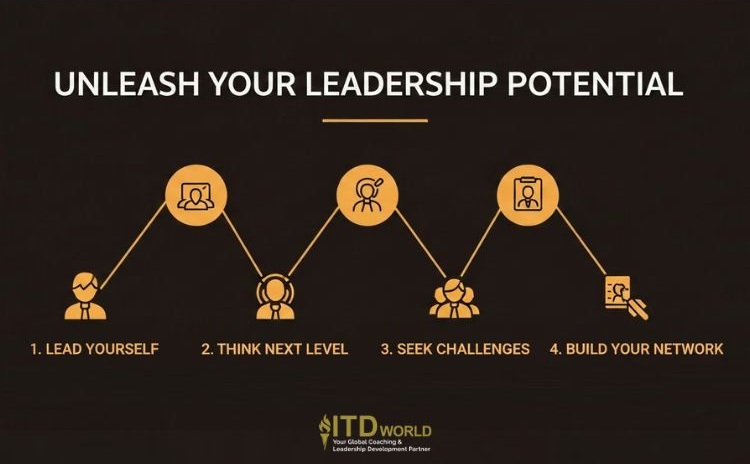A professional framework for identifying leadership potential and activating the future leaders within your own ranks.
Deep within every organization lies its most valuable (and often invisible) asset: the leadership potential of its people. While many companies tend to emphasize rewarding past performance, the most strategic ones are focused on cultivating future capability instead. The practice of identifying and developing leadership potential is the key to unlocking sustainable growth and building a company that thrives for generations.
|
Author: Jonathan M. Pham |
Highlights
- Leadership potential is an individual’s capacity and motivation to successfully take on broader, more complex, and more senior roles in the future; it involves a combination of innate ability, learnable skills, and personal drive.
- Identifying and cultivating high-potential leaders is a crucial, high-return investment for organizations – as it drives succession, stability, and cost savings, boosts employee engagement and retention, and fuels innovation and organizational agility.
- The Silzer and Church’s model defines leadership potential by assessing three key areas: foundational dimensions (cognitive abilities and personality traits), growth dimensions (learning agility and motivation for advancement), and career dimensions (leadership skills and functional/technical competence).
- Assessing leadership potential requires a holistic approach that goes beyond typical performance reviews, utilizing behavioral interviews to uncover growth factors, 360-degree feedback for insights into career dimensions, and objective assessment tools for foundational traits and growth factors.
- To activate and unleash your leadership potential, it is essential to engage in rigorous self-reflection, elevate your performance to demonstrate strategic impact, actively seek out more challenging opportunities, and build a personal “board of directors” including mentors and sponsors. For organizations, they need to train leaders to identify signs of future growth beyond current performance, build personalized development roadmaps for high-potential individuals, and utilize stretch assignments to accelerate their growth through real-world challenges.
- Common challenges to resolve include the “mini-me” bias leading to homogenous talent, the risk of “potential burnout” from excessive pressure, and the loss of developed talent to competitors due to unclear internal career paths.
What is Leadership Potential?
Leadership potential (also referred to by other names such as “leadership capacity”, “leadership talent”, “leadership aptitude”, “potential for leadership”, etc.) is the capacity and motivation within an individual to successfully take on broader, more complex, and more senior roles in the future. It is a combination of innate ability, learnable skills, and personal drive.
It’s essential to make a distinction between high performance and high potential. The former is about excelling at the tasks and responsibilities of one’s current job (in other words, it is mastery of the present). On the other hand, the latter is about demonstrating the aptitude and ambition to succeed in a future, more challenging role; it is the capacity for growth and scale.
While many high-potential individuals are also high performers, not every high performer has leadership potential. For instance, let’s say a top salesperson consistently exceeds their quota and is a master of building client relationships (high performance). However, this does not automatically mean they are suited to become the Vice President of Sales – as the position requires a completely different skill set: developing other leaders, managing a complex budget, and thinking strategically about the market. The salesperson may or may not possess the aptitude and aspiration to acquire these new qualities.

High potential leadership
The Importance of High Potential Leaders
Identifying and cultivating leadership potential is not just a “nice-to-have” talent management activity; it is one of the most high-return investments an organization can make.
- Drives succession, stability, and cost savings
A robust pipeline of internal leaders is the ultimate insurance policy against the risk and disruption caused by unexpected departures. Promoting from within is not only faster but also significantly more cost-effective and successful than hiring externally.
According to research by SHRM, external hires can cost significantly more than internal promotions and often have a higher failure rate within the first few years as they struggle to adapt to the new company culture.
- Boosts engagement & retention
High-potential employees are ambitious and motivated by growth. If they do not see a clear and credible path for advancement within your organization, they are likely to find one elsewhere.
Gallup’s studies have consistently concluded that opportunities for professional development are among the top drivers of employee engagement and retention. Investing in high-potentials signals that you value their future, making them far more likely to commit their long-term career to the organization.
- Fuels innovation & organizational agility
Your high-potential employees are typically the source of your most innovative ideas – as well as the energy needed to drive change. When you identify and empower them, you are investing in the company’s ability to adapt and evolve. In fact, research has concluded that organizations that are effective at developing their leadership talent are more agile and better equipped to respond quickly to market changes and competitive threats.
The Anatomy of Leadership Potential: Silzer and Church’s Model
Identifying leadership potential requires looking beyond surface-level performance. It demands a structured framework that assesses the multiple facets of an individual’s capability and motivation.
One of the most respected and comprehensive models, proposed by Robert Silzer and Allan H. Church, breaks the concept down into three key areas as follows:
-
Foundational dimensions
These are the underlying cognitive abilities and personality traits that form the raw material for leadership. While not impossible to change, they are relatively stable and serve as the base upon which other skills are built.
- Cognitive capabilities: The ability to process complex information, think critically and analytically, and make sound judgments with incomplete data.
- Personality characteristics: Traits like emotional stability under pressure, strong interpersonal skills, and a baseline level of sociability and assertiveness.
A consistent inability to handle complexity or a resistance to collaboration can be a significant limiting factor, even if other capacities are present.
-
Growth dimensions
This is the motivational engine that determines whether an individual will actively seek to grow and capitalize on their foundational abilities. It’s not just about what they CAN do, but what they WILL do.
- Learning agility: The enthusiasm to learn from all experiences (both successes and failures), actively seek out new and challenging situations, and apply those learnings to future challenges. It is generally considered the single most important indicator of leadership potential.
- Motivation & aspiration: A clear and genuine ambition to take on larger, more complex roles, coupled with a strong inner drive to succeed, make a significant impact, and leave a lasting legacy.
One of the biggest red flags in this dimension is a defensiveness to feedback or a lack of curiosity. An individual who is not open to learning, regardless of their innate talent, has a very low potential for significant growth.
-
Career dimensions
These are the specific, learnable competencies required to succeed in leadership roles. This is the dimension where training, coaching, and development have the most direct and powerful impact.
- Leadership skills: The full range of people-centric capabilities, such as motivating, influencing and inspiring others, growing people through coaching, communicating a vision, and managing stakeholders.
- Functional & technical competence: A deep understanding of one’s specific function (e.g. marketing, finance, operations) and the broader business acumen to realize how the company as a whole creates value.
A common derailer is a leader who remains technically brilliant in their function but consistently fails to develop or empower their people. It is a strong indicator that they have not made the crucial transition from “doing” to “leading.”
Based on Silzer and Church’s model, we can come up with a formula for leadership potential as follows:
Leadership Potential = (Foundational Dimensions + Growth Dimensions) x Career Dimensions

Key aspects & characteristics of high potential leaders
(Source: ResearchGate)
How to Assess Leadership Potential
Identifying potential requires gathering data from multiple sources to get a holistic picture of an individual’s capabilities across all three dimensions – Foundational, Growth, and Career.
- Look beyond the performance review
As mentioned, we need to remember that High Performance ≠ High Potential. A traditional performance review is excellent for evaluating an individual’s contributions and mastery in their current role. And yet, it is often a poor predictor of success in a future, more complex role. A comprehensive assessment, therefore, must look for evidence of the full anatomy of potential.
- Use behavioral interviews to probe for growth factors
You can uncover key “Growth Dimensions” like learning agility and resilience by posing specific, open-ended questions about how an individual has handled past experiences.
Example: Instead of “Are you a good learner?”, ask a behavioral question like: “Tell me about a time a major project you were on failed. What was your role, and what specific lessons did you take away from that experience that you have applied since?” The answer should reveal their capacity for self-awareness, willingness to take ownership, and ability to learn from adversity.
- Implement 360-degree feedback
This is the ideal tool for assessing an individual’s “Career Dimensions,” especially their leadership and interpersonal skills. By gathering confidential, anonymous input from their manager, peers, and direct reports, you get a well-rounded view of their actual on-the-job behavior and impact – including hidden strengths (e.g., “is a fantastic informal mentor to junior staff”) and critical blind spots (e.g., “struggles to delegate”) that may not be visible in a standard performance review.
- Leverage tools for objective data
For high-stakes succession planning, many organizations use professional, scientifically validated assessment tools to add an objective layer of data and reduce bias in the selection process. Well-regarded instruments, like the Korn Ferry Assessment of Leadership Potential, are specifically designed to measure many of the foundational traits and growth factors discussed previously.

A Blueprint for Activating & Unleashing Your Leadership Potential
-
Start with rigorous self-reflection
You cannot develop your potential if you are not deeply aware of your starting point. The first step to demonstrating leadership is by leading yourself with a commitment to continuous self-assessment. That means regularly carving out time to reflect on your progress and ponder questions such as:
- “What are my core strengths, and how can I leverage them?”
- “What are my key development areas, and what is my plan to address them?” and
- “Do my daily actions align with the leader I aspire to be?”
Over time, frequent self-reflection should contribute to the self-awareness foundational to growth.
Read more: Leadership Branding – Crafting an Inspiring Personal Identity
-
Move from “good” performance to “great” impact
Excellence in your current role is the absolute prerequisite for being considered for more. However, to demonstrate potential, you must go beyond simply hitting your targets – and show you can think at the next level. Don’t just complete your assigned tasks; you need to understand the “why” behind them.
Example: In team meetings, rather than simply reporting on your own work, try to contribute insights that show you are well aware of how your team’s efforts connect to the broader business strategy. That is how you move from being a good performer to being seen as a great potential leader – by demonstrating not just what you can DO, but how you can THINK.
-
Raise your hand for more challenges
Leadership potential is proven through action. One of the best ways to prove readiness for more responsibility is to successfully handle more complex and challenging work – which starts with actively volunteering for high-visibility, cross-functional projects that push you outside of your day-to-day comfort zone.
Example: Taking the lead on an initiative that requires collaboration with teams from finance, marketing, and operations proves your ability to influence peers, manage complexity, and deliver results – all key indicators of senior leadership potential.
Read more: Visibility at Work – Key to Sustainable Career Advancement
-
Establish your personal “board of directors”
No leader succeeds alone. Building a strategic network of supporters and advisors is a critical part of managing your leadership journey.
It is recommended that you intentionally seek out and nurture two critical types of relationships:
- A mentor: An experienced leader capable of offering confidential advice, sharing their wisdom, and helping you navigate challenges.
- A sponsor: A senior, influential leader who believes in your potential and will advocate for you in high-level talent discussions and succession planning meetings.

Leadership potential blueprint
How Organizations May Cultivate Leadership Potential
A robust leadership pipeline is a strategic imperative that requires a deliberate and systematic approach.
-
Look further than performance
The first step is to train your current leaders to look beyond today’s performance metrics and spot the early signs of leadership potential. This requires observing a different set of behaviors that indicate an aptitude for future growth.
What to look for:
- Insatiable curiosity: They are not content with just doing their job; rather, they consistently ask “why?” and seek to understand how their work connects to the broader business strategy.
- Volunteering for difficult assignments: They are willing to take on challenging, often unglamorous, cross-functional projects because they are motivated by learning and making an impact, not just by visibility.
- Natural “talent magnets”: Peers naturally gravitate to them for advice, guidance, and collaboration, even when they have no formal authority.
- High learning agility: When they face a setback or a failure, their immediate focus is on what can be learned from the experience, rather than on assigning blame.
-
Build personalized development roadmaps
Once a high-potential individual is identified, a generic, one-size-fits-all training program is not enough. The organization should partner with them to create a tailored development plan that addresses their specific gaps and aligns with their career aspirations.
Example: A growth roadmap for a high-potential director might include a combination of methods, such as one-on-one coaching to hone their executive presence, enrollment in a senior leadership program to build their financial acumen, and a mentorship pairing with a C-suite executive to acquire enterprise-level perspective.
-
Use “stretch assignments” as a development accelerator
The fastest way to grow and test leadership potential is to give individuals the opportunity to practice their skills in a challenging, real-world environment – i.e. granting them ownership of a significant business challenge outside their current scope of responsibility.
Example: Task a high-performing marketing director with leading a task force to improve the efficiency of the customer support process. This “stretch” assignment will force them to learn about a different part of the business, influence stakeholders over whom they have no authority, and think systemically – all crucial capabilities for a future enterprise leader. As they tackle the task, they are also given a visible platform to demonstrate their leadership potential in action.

Challenges of Identifying & Cultivating Leadership Potential
- The “mini-me” bias in identification
People have a natural, often unconscious, tendency to gravitate towards and identify potential in individuals who look, think, and act like themselves. This “mini-me” effect may result in a homogenous leadership pipeline, causing the organization to overlook diverse talent with different but equally valuable perspectives and skills.
Solution: To mitigate bias, you must move beyond a single manager’s opinion. A good idea is to implement validated assessment tools that measure core potential traits objectively. Additionally, it is crucial to establish a talent review committee with members from different functions of the business to discuss and calibrate all high-potential nominations. This ensures that candidates are evaluated against a consistent standard from multiple viewpoints.
Read more: Ego in the Workplace – The Hidden ‘Evil’ Behind Team Dysfunctions
- The risk of “potential burnout”
Once an individual is labeled as “high-potential,” they are likely to be given the toughest assignments, the most ambitious goals, and are held to an incredibly high standard. Without adequate support, this constant pressure will lead to exhaustion, disillusionment, and burnout.
Solution: A high-potential employee should never be simply thrown into a “stretch” assignment and left to sink or swim. Instead, the organization must ensure a strong support structure. For example, they need to assign a senior mentor/ executive coach who can help the individual navigate the political and technical challenges of their new responsibilities, process their own emotions, and hone their leadership style.
- Losing your developed talent to competitors
This is perhaps the most frustrating outcome for any business. You invest heavily in cultivating a high-potential leader, only for them to take their newly enhanced skills to a competitor for their next big role.
Solution: Link development directly to a clear internal career path. High-potential employees are ambitious. If they do not see a clear and credible path forward within the company, they will inevitably start looking outside of it.
In practice: Leaders must have regular and candid career path conversations with their high-potential talent – and be as transparent as possible about potential future roles and timelines. A statement like, “The successful completion of this project is a key step in preparing you for the Director-level role we envision for you in the next 18-24 months,” can create a powerful incentive to stay and grow with the organization.
Quotes About Leadership Potential
Leadership is unlocking people’s potential to become better.
Bill Bradley
Before you are a leader, success is all about growing yourself. When you become a leader, success is all about growing others.
Jack Welch
The function of leadership is to produce more leaders, not more followers.
Ralph Nader
The single biggest way to impact an organization is to focus on leadership development. There is almost no limit to the potential of an organization that recruits good people, raises them up as leaders and continually develops them.
Average leaders raise the bar on themselves; good leaders raise the bar for others; great leaders inspire others to raise their own bar.
Orrin Woodward
Great leaders don’t set out to be a leader, they set out to make a difference. It’s never about the role, it’s always about the goal.
Lisa Haisha
A leader takes people where they want to go. A great leader takes people where they don’t necessarily want to go, but ought to be.
Rosalynn Carter
Good leaders build products. Great leaders build cultures. Good leaders deliver results. Great leaders develop people. Good leaders have vision. Great leaders have values. Good leaders are role models at work. Great leaders are role models in life.
Adam Grant

How to demonstrate leadership
Unleash Your Leadership Potential with ITD World
At ITD World, we specialize in enabling organizations to cultivate a deep bench of future-ready leaders. We partner with you to create and implement a comprehensive strategy for managing your leadership potential, ensuring you have the talent needed to drive your business forward for years to come.
Our integrated solutions are designed to support every stage of the journey:
- Leadership potential assessments: We provide expert assessment services, using validated tools and frameworks to help you objectively identify the high-potential individuals within the organization and pinpoint their specific development needs.
- Customized in-house programs: We partner with you to design and deliver bespoke growth programs for your high-potential cohorts. These journeys blend formal training, action learning, and “stretch” assignments to foster the critical skills needed for future roles.
- Executive coaching & mentoring solutions: To accelerate the process and support your rising stars through their challenges, we offer world-class executive coaching services that connect your talent with experienced guides.
Ready to identify and cultivate the next generation of leaders? Contact ITD World today to learn how our solutions can help!
Other resources you might be interested in:
- Leading Through Uncertainty: How to Navigate Turbulent Times
- Leadership Effectiveness: From Intent to Impact
- Transformational Leadership: Inspiring Change & Growth
- Leadership Philosophy: How to Define Your True North & Follow It
- Future Ready Organization: 11 Tips to Building One

